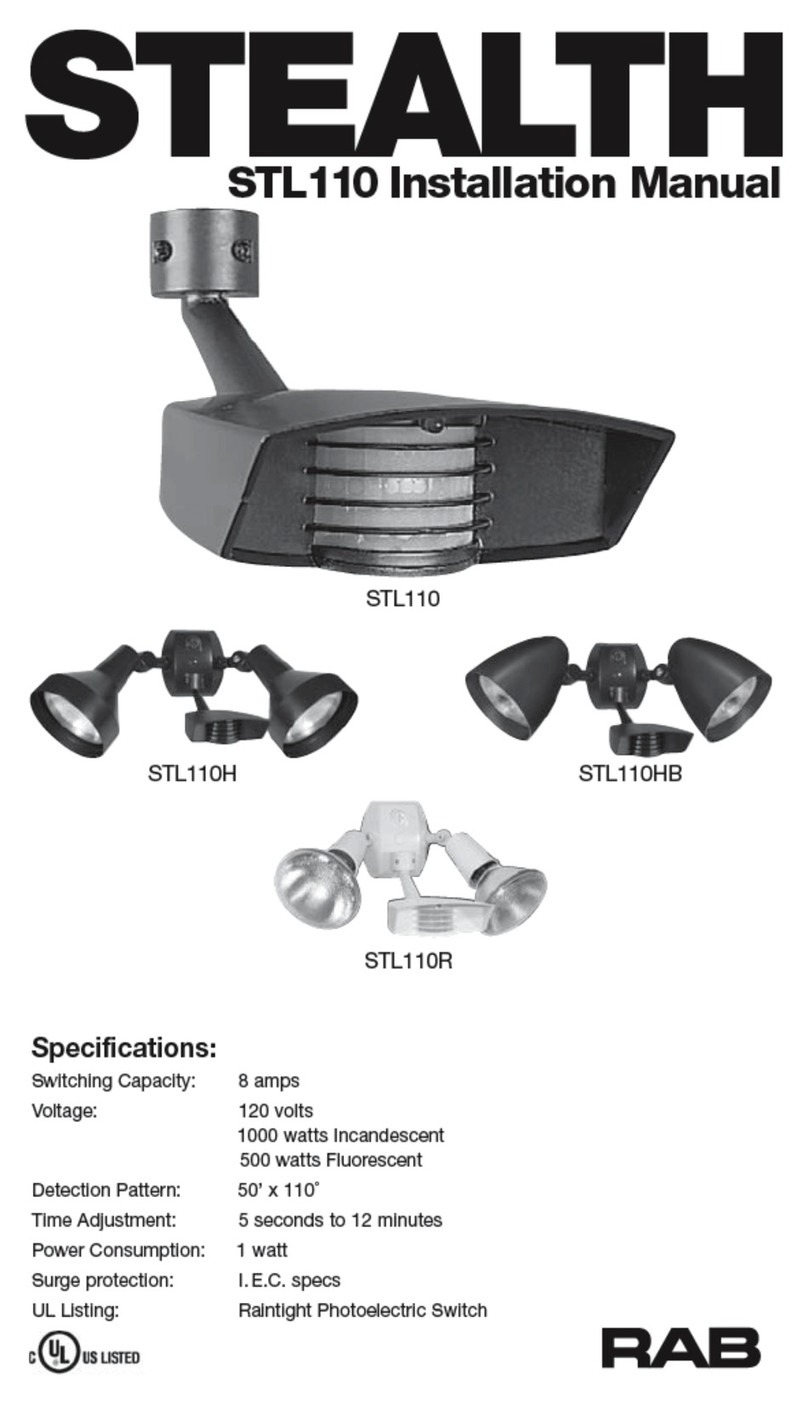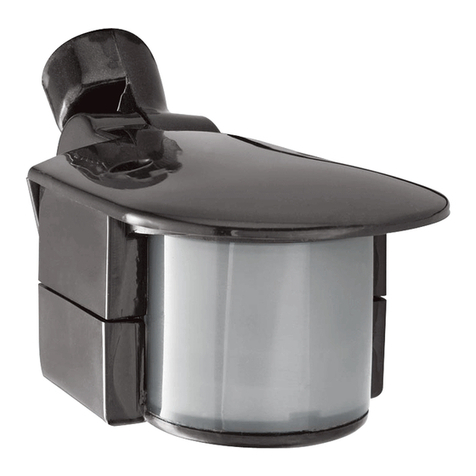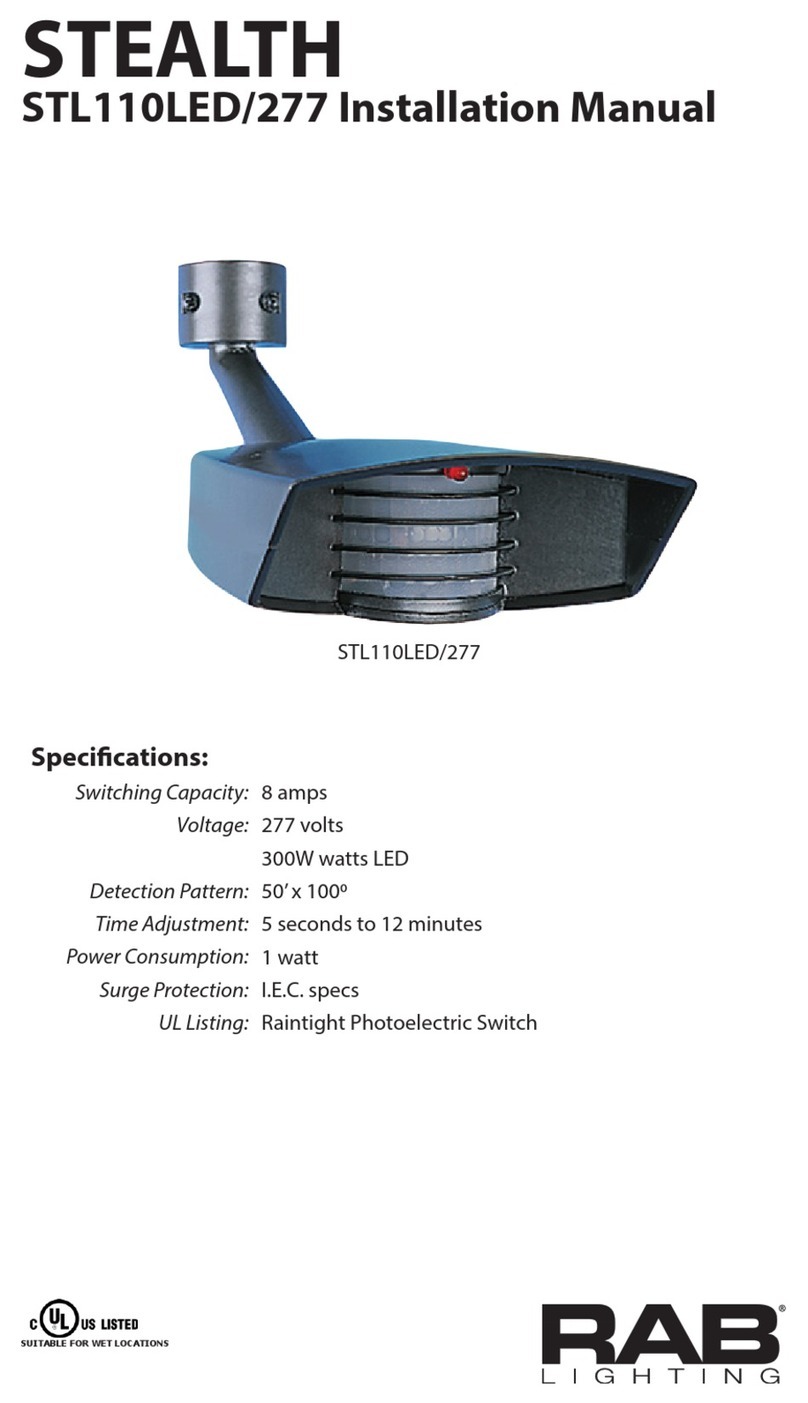
1. Lights may turn on occasionally during
rain, snow and windstorms because
the sensor is detecting changes in
temperature. If this is a constant
problem, mount the sensor in a more
protected area.
2. Tilt the sensor lower - it may be seeing
distant objects moving.
3. You may not be aware that animals have
triggered sensor. Check sensor aiming
to reduce nuisance triggering or mask
the lower part of the lens with opaque
weatherproof tape.
4. The sensor may turn on occasionally
during voltage surges.
5. A possible source of“mysterious”sensor
activations are strong local radio signals.
Check for nearby CB, Ham, VHF radio
transmitters or Cellular telephones. The
sensor may be activated, but will not be
permanently impaired by these signals.
6. Check other solutions mentioned under
on pages 12 &13.
Toll-Free Technical Assistance
If you need technical assistance, please do
the following:
1. Re-read the Technical Tips sections of
this manual.
2. Call the Tech Help Line at 888 722-1000,
8AM to 6PM Eastern Time M-F and we
will be glad to help you. Before you call,
please have the following information
handy:
The RAB SmartBox will be free from defects in
materials and workmanship for a period of five (5)
years from the date of delivery to the end-user.
Sensors must be installed by a properly insured
and licensed electrician or under the supervision
of a licensed electrician and the product must be
in its original, unopened and new condition at
the time of installation. The information provided
in the RAB Sensor Owner’s Manual is critical in
determining the location, conditions, intended
use and other requirements with respect to
the use and installation of a sensor product.
Using a sensor product in any manner other
than as disclosed in the RAB Owner’s Manual
automatically voids the warranty.
Exceptions. The above warranties shall not apply
and RAB makes no representations or warranties
with respect to:
a. problems caused by acts of God including
without limitation lightning strikes; and
b. problems caused by any improper action or
failure to act by any person or entity other RAB,
including without limitation problems caused by
improper installation by the buyer, an authorized
RAB distributor, or any other person or entity; and
c. using or installing a sensor product in any
manner other than as disclosed in the RAB
Owner’s Manual.
d. use with Instant Start ballasts; use with Instant
Start ballasts will void the RAB warranty.
Out of warranty sensors replacement program.
If your sensor is out of warranty or if damage is
unrelated to its original manufacture, return your
sensor (freight prepaid and insured) directly to us
(at RAB Lighting Inc. 170 Ludlow Ave. Northvale,
NJ 07647) with a check for $20.00 made payable
to RAB Lighting Inc. We will repair or replace your
sensor promptly.
14 15
Note: These instructions do not cover
all details or variations in equipment
nor do they provide for every possible
situation during installation operation or
maintenance.
a) Catalog number of your unit;
b) Wattage, types and locations of lights
connected to the sensor;
c) The electrical circuit on which the
sensor is installed. What else does
it feed? How is the sensor power
switched?
d) Serial Number (4 digits) on the back
of the sensor.
e) This installation Manual
RAB Lighting cannot give electrical wiring
instructions by phone. Please consult a
qualified electrician
The following warranties apply to RAB Lighting, Inc. (“RAB”)
products that meet all of the following conditions: (a) the
product was purchased by the contractor or end-user from an
authorized RAB distributor who purchased the product directly
from RAB and from no other source; (b) if the product has been
installed, the entire installation was performed by a licensed
electrician or under the supervision of a licensed electrician
and the product was in its original, unopened and new
condition at the time of installation. RAB LIGHTING DISCLAIMS
ALL REPRESENTATIONS AND WARRANTIES WITH RESPECT TO
ALL OTHER PRODUCTS, INCLUDING WITHOUT LIMITATION
PRODUCTS THAT HAVE BEEN PURCHASED FROM ANY PERSON
OR ENTITY OTHER THAN AN AUTHORIZED RAB DISTRIBUTOR,
OR INSTALLED BY ANY PERSON OR ENTITY OTHER THAN A
LICENSED ELECTRICIAN OR UNDER THE SUPERVISION OF A
LICENSED ELECTRICIAN, AND ALL PRODUCTS THAT ARE USED
OR ARE OTHERWISE NOT IN THEIR ORIGINAL RAB LIGHTING
PACKAGING AT THE TIME OF INSTALLATION.
Remedy. RAB’s obligations for breach of warranty shall be
limited to repair or replacement, at RAB’s option, of any
products or parts which prove to be defective, provided that
buyer gives RAB written notice and returns the defective
product to RAB in accordance with RAB’s return material
authorization (RMA) policies, and RAB confirms the defect.
Buyer is responsible for all costs to de-install defective products
and re-install replacement or repaired products and RAB shall
not be liable for labor or other costs related to de-installation
or re-installation.
DISCLAIMER. THE FOREGOING WARRANTIES ARE IN
LIEU OF, AND RAB EXPRESSLY DISCLAIMS, ALL OTHER
REPRESENTATIONS, GUARANTEES AND WARRANTIES, EXPRESS
OR IMPLIED IN FACT OR BY LAW, INCLUDING WITHOUT
LIMITATION ALL WARRANTIES OF MERCHANTABILITY OR
FITNESS FOR A PARTICULAR PURPOSE OR OTHERWISE. THE
FOREGOING WARRANTIES STATE RAB’S ENTIRE AND EXCLUSIVE
LIABILITY, AND BUYER’S SOLE AND EXCLUSIVE REMEDY, IN
CONNECTION WITH THE PRODUCTS AND ALL PARTS, THEIR
DESIGN, SUITABILITY FOR USE, INSTALLATION AND OPERATION.
LIMITATION OF LIABILITY. RAB shall not be liable under
any theory of relief, including without limitation breach of
warranty, breach of contract, tort (including negligence), strict
liability, or otherwise, arising out of or related to any breach
of warranty, any RAB products and the use thereof, or any
other acts or omissions of RAB for: (i) any indirect, incidental,
special or consequential damages, whatsoever (including
without limitation, loss of anticipated value of a business or
its reputation) or (ii) any damage or loss in excess of the price
actually paid by buyer to the authorized RAB distributor for
the products that caused the damages. Any action by buyer
must be commenced within one year after the cause of action
has accrued.
Miscellaneous. These product warranty terms shall be
governed by the laws of the State of New York. Buyer consents
to the personal jurisdiction and venue of the courts of the
State of New York. Any legal or equitable claim of any nature
arising hereunder shall be filed and maintained in the state or
federal courts in the State of New York and buyer agrees that
such courts are a convenient forum for adjudication. In the
event that suit is necessary to recover amounts owed RAB,
RAB Lighting
Product Warranties
Technical Tips:
Lights Turn On For Unknown
Reasons
Masking the lens
buyer shall be liable for reasonable attorney’s fees, interest and
costs of collection. No agreement or understanding varying
the terms and conditions hereof shall be binding upon RAB
or buyer unless in writing and signed by duly authorized
representatives of both parties. These product warranty terms
shall inure to the benefit of and be binding upon the parties
hereto and their respective successors and assigns.
RAB Sensor Warranty






























